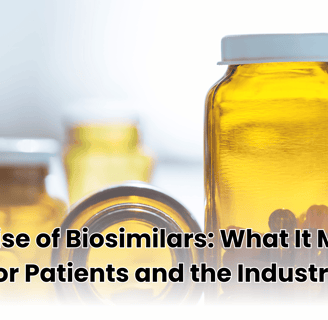The Rise of Biosimilars: What It Means for Patients and the Industry
In recent years, biosimilars have emerged as a game-changer in the pharmaceutical landscape, offering new possibilities for both patients and the healthcare industry. As these biologic medicines gain traction globally, it’s essential to understand their significance, benefits, and challenges. Let’s explore what biosimilars are and how they are shaping the future of medicine.
1/16/20252 min read


What Are Biosimilars?
Biosimilars are highly similar to already approved biologic drugs, known as reference products, in terms of safety, efficacy, and quality. Unlike generic drugs, which are identical chemical compounds to their brand-name counterparts, biosimilars are derived from living organisms and involve complex manufacturing processes. Despite these differences, biosimilars provide the same therapeutic benefits as their reference products.
Why Are Biosimilars Important?
Increased Access to Treatment Biosimilars offer a more affordable alternative to expensive biologics, making life-saving treatments accessible to a broader patient population. This is particularly crucial for chronic conditions such as cancer, rheumatoid arthritis, and diabetes, where long-term treatment costs can be prohibitive.
Cost Savings for Healthcare Systems The introduction of biosimilars helps reduce overall healthcare expenditures. Lower drug prices allow governments and insurers to allocate resources to other critical areas, such as preventive care and innovative research.
Fostering Innovation As biosimilars enter the market, they create healthy competition, encouraging pharmaceutical companies to invest in next-generation therapies and improve existing treatments.
How Do Biosimilars Impact Patients?
For patients, the availability of biosimilars translates to improved access and affordability. For instance:
Reduced Financial Burden: Biosimilars lower out-of-pocket costs, making essential treatments more accessible.
Improved Outcomes: Increased access to biologic treatments can lead to better disease management and quality of life.
Patient Confidence: Regulatory agencies like the FDA and EMA rigorously evaluate biosimilars, ensuring they meet the same standards as reference biologics.
Challenges Facing Biosimilars
Despite their potential, biosimilars face several hurdles:
Regulatory Complexity Developing and gaining approval for biosimilars is a time-consuming and costly process, involving extensive clinical trials to demonstrate similarity.
Market Acceptance Physicians and patients may hesitate to switch from reference biologics to biosimilars due to concerns about efficacy and safety, despite regulatory assurances.
Intellectual Property Issues Patent disputes and exclusivity rights often delay the entry of biosimilars into the market, limiting their impact.
The Future of Biosimilars
The global biosimilars market is poised for significant growth, driven by patent expirations of blockbuster biologics, increasing demand for cost-effective therapies, and supportive regulatory frameworks. Key trends to watch include:
Expanded Indications: Biosimilars are being developed for a wider range of diseases, including rare and orphan conditions.
Technological Advancements: Innovations in manufacturing and analytical techniques are improving the efficiency and affordability of biosimilar production.
Educational Efforts: Initiatives to educate healthcare providers and patients about biosimilars are crucial for boosting acceptance and confidence.
Conclusion
The rise of biosimilars marks a pivotal moment in the pharmaceutical industry. By offering high-quality, affordable alternatives to biologics, biosimilars have the potential to transform patient care and alleviate the financial burden on healthcare systems worldwide. However, addressing regulatory, market, and educational challenges will be key to unlocking their full potential. As biosimilars continue to gain momentum, they promise a future where cutting-edge treatments are within reach for everyone.
